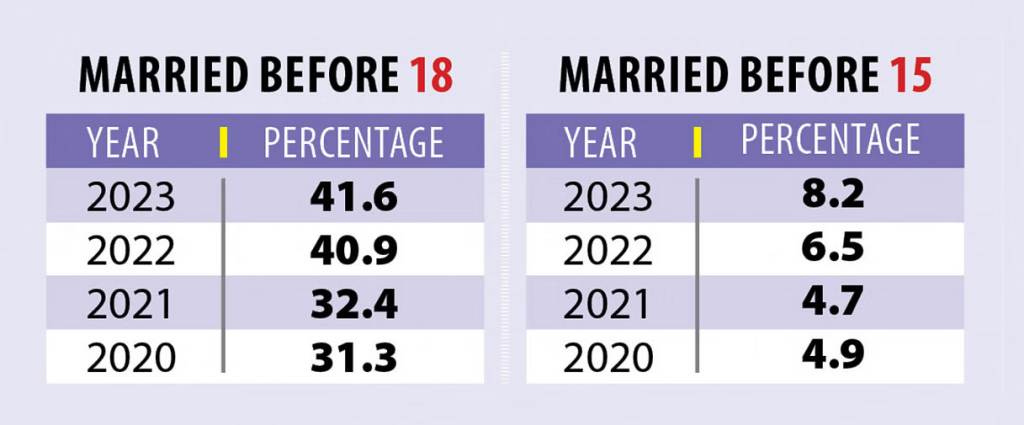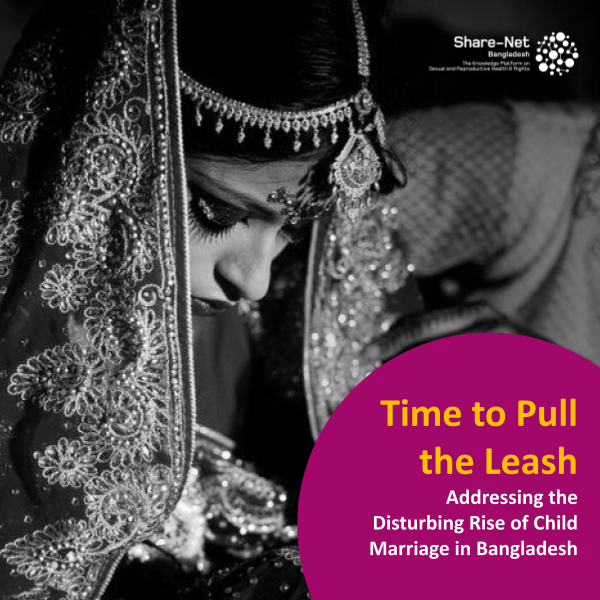Time to Pull the Leash: Addressing the Disturbing Rise of Child Marriage in Bangladesh
“Child marriage perpetuates a cycle of poverty by cutting short the girls’ education, pushing them into early and repeated pregnancies, and limiting their employment opportunities,” says Shaheen Anam, executive director of the Manusher Jonno Foundation.
This sentiment echoes the recent findings of the Bangladesh Sample Vital Statistics-2023 (BSVS-2023), which reveal a distressing reality: at least 41.6 percent of young women in Bangladesh were married before they turned 18.
The statistics from the BSVS-2023, conducted by the Bangladesh Bureau of Statistics (BBS), paint a worrying picture of a rising trend of child marriages over the past three years. In 2022, 40.9 percent of women were found to have been married before turning 18, up from 32.4 percent in 2021 and 31.3 percent in 2020. Moreover, 8.2 percent of young women had gotten married before they were even 15 years old, a significant increase from the previous year’s 6.5 percent.

These numbers underscore the urgent need to address the root causes behind the prevalence of child marriage in Bangladesh. Experts attribute the phenomenon to a complex interplay of factors including poverty, safety concerns, and deeply entrenched social norms and customs.
“The main drivers include social norms, safety concerns, and poverty,” explains Shaheen Anam. “Marrying off daughters is perceived as a solution due to concerns about elopement, safety concerns, and poverty, particularly prevalent in climate change-affected and remote areas where families see it as one less mouth to feed.”
While the legal age for marriage in Bangladesh is 18 for women, the enforcement of the Child Marriage Restraint Act 2017 remains a challenge. Despite mandates for the establishment of child marriage prevention committees at various levels, including national, district, upazila, and union, proper enforcement lags behind. Dysfunctionality within these committees further exacerbates the issue, leaving many young girls vulnerable to early marriage.
The consequences of child marriage extend far beyond the act itself. It perpetuates a cycle of poverty by depriving girls of education and economic opportunities, and it poses serious risks to their sexual and reproductive health rights (SRHR). Adolescent pregnancies, a direct consequence of child marriage, compromise the health and wellbeing of young girls, as their bodies are often not physically ready for childbirth.
“The increasing trend of child marriage also results in a very high rate of adolescent pregnancies,” states the BSVS-2023. “The rate of girls aged between 15 and 19 giving birth to children is alarming, indicating that more children are being married off and they are becoming pregnant in their teens.”
Experts emphasise the urgent need to change societal perceptions towards girls and take decisive action to address the challenges of child marriage and teenage pregnancies, particularly in rural areas where the prevalence is highest. Awareness campaigns focusing on the negative effects of child marriage and the importance of girls’ education are crucial steps towards combating this issue.
In addition to awareness-raising efforts, there is a pressing need for stronger enforcement of existing laws and the proper functioning of child marriage prevention committees. By prioritising the rights and wellbeing of young girls, Bangladesh can work towards ending the scourge of child marriage and building a brighter future for its youth.
The time to act is now. By addressing the root causes of child marriage and prioritising SRHR, Bangladesh can pave the way for a more equitable and prosperous society for all its citizens.
Source: The Daily Star The Business Standard


